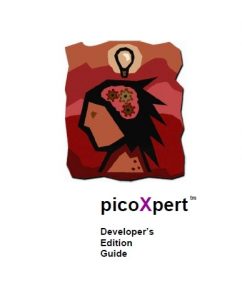
picoXpert was one of the first (if not THE first) handheld artificial intelligence (AI) tools ever. It provided for the capture of human expert knowledge and later access to that knowledge by general users. It was a simplistic, yet portable implementation of an Expert System Shell. Here is the brief story of how it came to be.
When I was about 10, my grandfather (an accomplished machinist in his day) gave me his slide rule. It was a professional grade, handheld device that quickly performed basic calculations using several etched numeric scales with a central slider. I was immediately captivated by its near-magical power.
In high school, I received an early 4-function pocket calculator as a gift. Such devices were often called ‘electronic slide rules’. It was heavy, slow, and sucked battery power voraciously. I spent many long hours mesmerized by its operation. I scraped my pennies together to try to keep up with ever newer and more capable calculators, finally obtaining an early programmable model in 1976. Handheld machines that ‘think’ were now my obsession.

I read and watched many science fiction stories, and the ones that most fired my imagination were those that involved some sort of portable computation device.
By 1980, I was building and programming personal computers. These were assembled on an open board, using either soldering or wire wrap to surround an 8-bit microprocessor with support components. I always sought those chips with orthogonality in memory and register architecture. They offered the most promise for the unfettered fields on which contemporary AI languages roamed. I liked the COSMAC 1802 for this reason. It had 5,000 transistors; modern processors have several billion. The biggest, baddest, orthogonal processor was the 16- or 32-bit Motorola 68000, but it was too new and expensive, so I used its little brother, the 6809, which was an 8-bit chip that looked similar to a 68000 to the programmer.
I spent much of the 1980s canoeing in Muskoka and Northern Ontario, with a Tandy Model 100 notebook, a primitive solar charger, and paperback editions of Asimov’s “Foundation” trilogy onboard (I read them five times). Foundations.
By the mid 1990s, Jeff Hawkins had created the Palmtm handheld computer. The processor he chose was a tiny, cheap version of the 68000 called the ‘DragonBall’. I don’t know which I found more compelling – this little wonder or the fact that it was designed by a neuroscientist. I finally had in my hand a device with the speed, memory, and portability to fulfill my AI dreams.

The 1990s saw the death of Isaac Asimov (one of my greatest heroes), but also saw me finally gaining enough software skills to implement a few Palm designs. These were mainly created in Forth and Prolog. The Mars Pathfinder lander in 1997 was based on the same 80C85 microprocessor found in the Tandy Model 100 that I had used over a decade earlier. This fact warmed my heart.
In 2001, I formed Picodoc Corporation, and released picoXpert.

Here are: the original brochure, an Expert Systems Primer, and a few slides.

It met with initial enthusiasm by a few, such as this review:
Handheld Computing Mobility
Jan/Feb 2003 p. 51
picoXpert Problem-solving in the palm of your hand
by David Haskin
However, the time for handheld AI had not yet come. After a couple of years of trying to penetrate the market, I moved on to other endeavours. These included more advanced AI such as Neural Networks and Agent-Based Models. In 2011, I wrote Future Psychohistory to explore Asimov’s greatest idea in the context of modern computation.
Picodoc Corporation still exists, although it has been dormant for many years. It’s encouraging to see the current explosion of interest in AI, especially the burgeoning Canadian AI scene. For those like me, who have been working away in near anonymity for decades, it’s a time of great excitement and hope. Today, I’m mainly into computational citizen science, and advanced technologies, such as blockchain, that might be applied to it.
